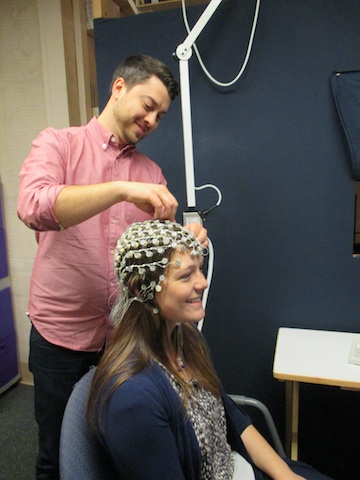 Welcome to the Bernier Lab’s new blog series “EEG Sessions”, where we will share with you EEG related topics, our thoughts on recent papers, and other relevant information from the Bernier Lab. To start off, we will describe why we measure brain activity using electroencephalography (EEG) and what the data represents.
Welcome to the Bernier Lab’s new blog series “EEG Sessions”, where we will share with you EEG related topics, our thoughts on recent papers, and other relevant information from the Bernier Lab. To start off, we will describe why we measure brain activity using electroencephalography (EEG) and what the data represents.
Here at the Bernier Lab, we research genotypes and phenotypes related to autism spectrum disorder (ASD), which means that we capture a thorough and multifaceted picture of each participant by integrating genetic sequencing, behavioral assessments, and neurophysiological measures. One of the neurophysiological measures we use regularly is electroencephalogram (EEG). EEG is a noninvasive procedure that tracks and records brain waves through electrodes that are affixed to the scalp. In our lab, we use an EEG netcap with hundreds of recording sites that is similar in structure to a swimming cap. EEG collects information about brain activity down to the millisecond(!), but it is hard to determine exactly where the brain signals originate within the brain. In other words, EEG provides a very reliable representation of when neural activity occurs, but we have to use discretion to determine where it occurs.
To better understand how brain activity relates to specific aspects of cognitive function, we control what our participants see or hear. Sometimes we show pictures or movies (with or without sounds). Other times we ask participants to sit quietly or close their eyes. We call this method “event-related potentials” (ERP), which refers to the fact that we record brain signals (i.e., potentials) in response to specific stimuli (i.e., events, such as a picture of a face). Stimuli may be visual (e.g. images flashing on a screen) or auditory (e.g. different beeps, tones, and sounds). We examine ERP responses in milliseconds and refer to specific parts of the brain activity, or brain waves, as ‘components.’ Components of interest are measured both in latency (When does the brain response occur?) and amplitude (How strong is the response?). There are predictable brain responses that occur at specific time points, often with expected amplitudes. In our ERP analyses, we measure selected components and compare them across different groups (e.g. children with ASD versus typically developing children).
In conducting EEG experiments, we hope to establish specific biomarkers that may aid in the diagnoses of autism. Currently, ASD can only be diagnosed through a series of clinical assessments. While these measures are reliable, they are built for toddlers and older children, simply due to the nature of the activities involved. Trying to diagnose children who are nonverbal or have cognitive impairments is especially challenging. Biomarkers could aid with diagnosis of children who are difficult to evaluate with traditional clinical ASD measures, including infants. This is especially significant because early intervention is critical and effective. If, for example, we found that a group of children with ASD share a brain signature that is different from other groups of children with ASD, we could use that knowledge to aid in early diagnosis and intervention. Designated biomarkers that aid early diagnosis of autism could also provide insight about anticipated behaviors and challenges for individual children. Such knowledge would be valuable in determining which treatments and therapies would be most beneficial for that child.
Establishing biomarkers for autism is no easy task. We know that ASD is a complex, multifaceted disorder, and as such, there will always be a number of factors that are difficult or impossible to address. Isolating ERPs can also prove challenging due to inherent brain differences associated with chronological age and developmental stage. Genetic events, comorbid disorders, and the heterogeneity of ASD further add to the complexity of establishing reliable biomarkers of autism. As a result, it is not uncommon for research to have mixed or contradictory findings. This is certainly true in EEG/ERP research. One of the goals of our EEG journal club is to think critically about existing research in order to improve our own methods and produce reliable findings with clinical applications.